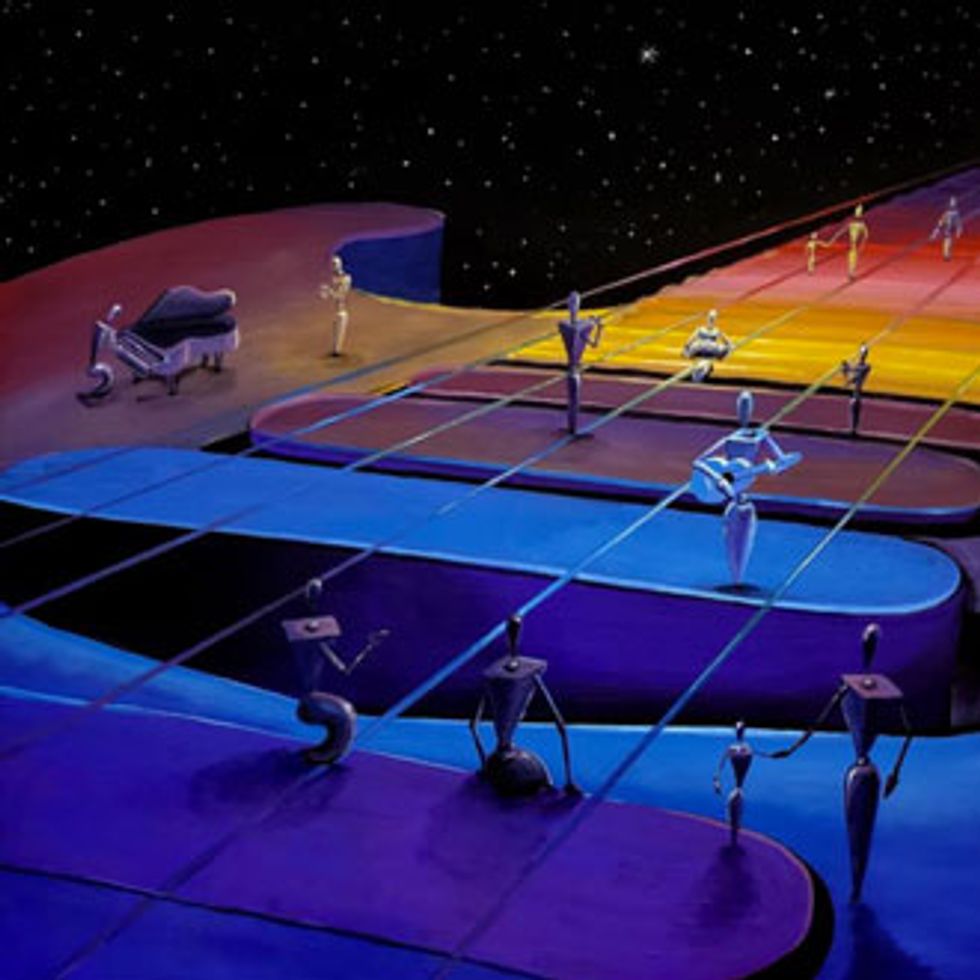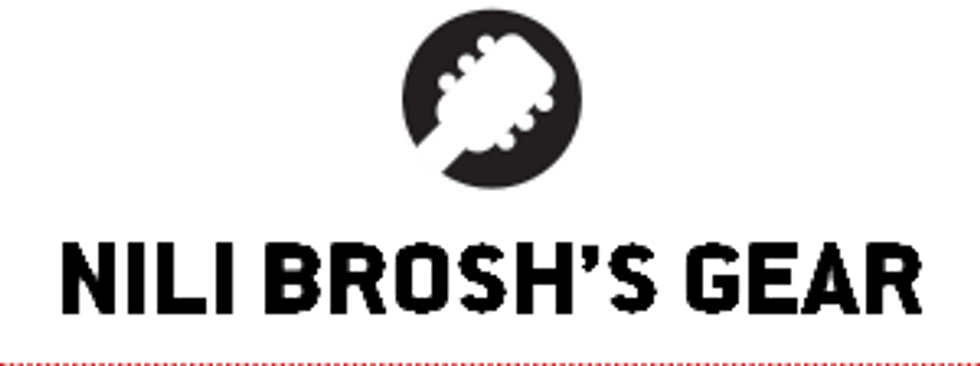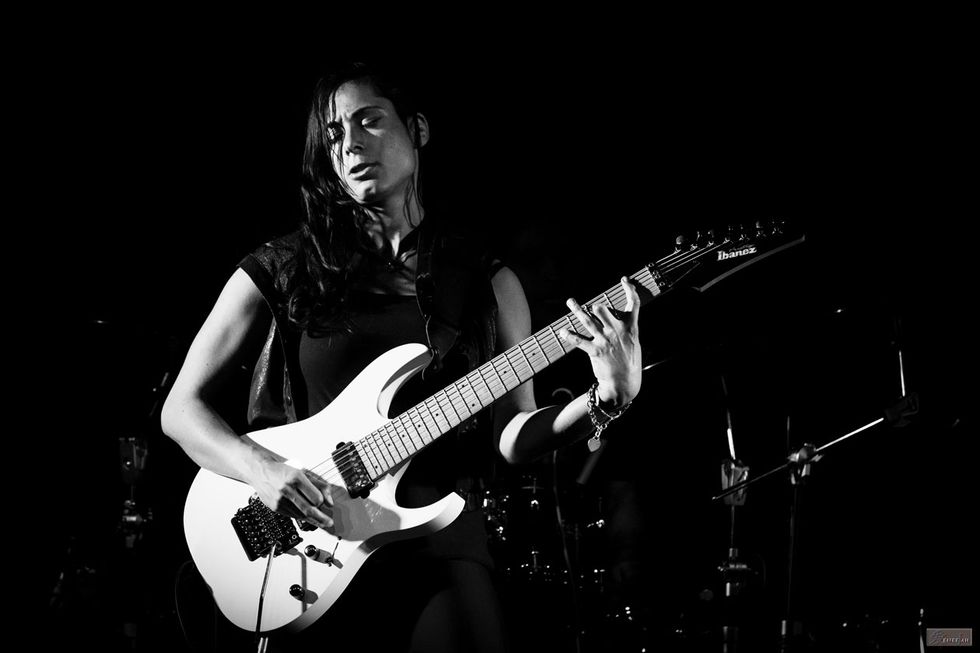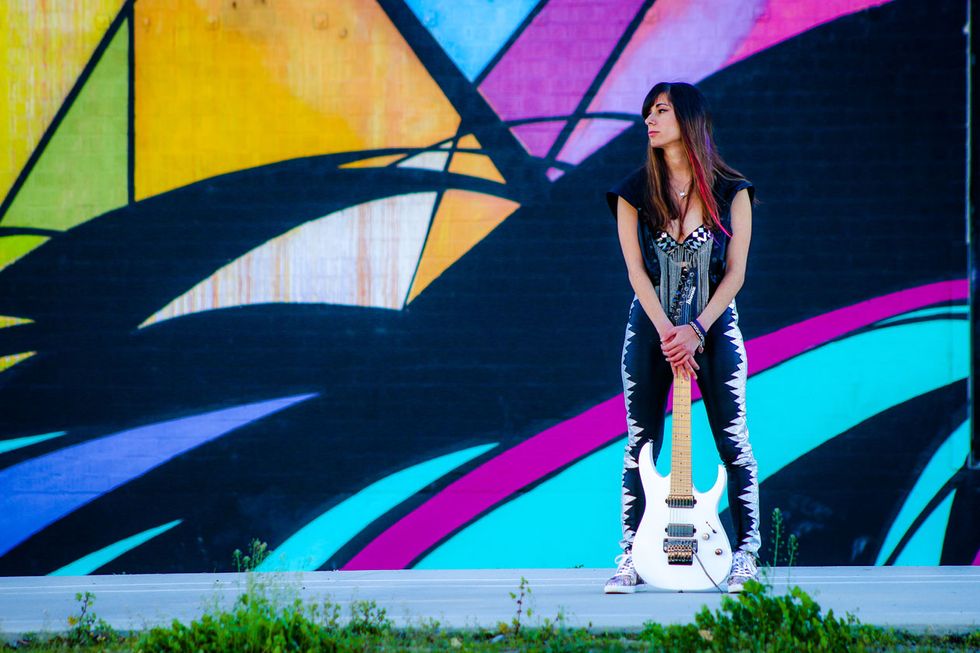Since graduating from Boston’s Berklee College of Music a decade ago, Nili Brosh has emerged as one of the planet’s preeminent progressive rock guitarists. During this time she released two fiery solo albums, worked with shred heroes Tony MacAlpine and her brother Ethan Brosh, toured with Jennifer Batten and Gretchen Menn, and performed in Cirque du Soleil’s Michael Jackson: ONE. Based on her recordings and band history, some might assume Brosh would continue to pursue the face-melting fretwork that brought her international acclaim.
But while working on Spectrum, her third and latest solo album, Brosh found herself with a collection of song ideas that were clearly inspired by genres she hadn’t explored before. “I didn’t really know where this was coming from,” she recalls. “I liked that it was happening, and I was happy with the music, but I just felt like, ‘Well, all this doesn’t really belong on one record, so I don’t know what I’m going to do.’”
Then it hit her: All the different genres she was experimenting with had a subtle common thread, some kind of “sonic thing,” as she puts it. “I realized I could, for lack of a better term, fade from one genre to the next, using those commonalities, so whatever you listen to next, it’s always going to have something from what came before.”
Once she had this conceptual epiphany, Brosh found it easier to use her talent for crafting melodies and hooks to unify Spectrum’s diverse compositions. This led to new sonic possibilities, as evidenced by the album’s first two songs, “Cartagena” and “Andalusian Fantasy,” which have a strong Spanish flavor. Instead of leading off with blazing electric lines, something her fans might expect, Brosh captivates the listener with effortless phrasing on a nylon-string guitar. From there, the mood morphs into the European-folk-inspired “Circus Wedding” and the Parisian/klezmer-influenced “Rachel in Paris,” which features accordion virtuoso Hubert Gall. By using her guitar to support the accordion and violin, Brosh exhibits a deep understanding of the genres referenced in her new songs and reveals a side of her musicianship that might surprise those expecting pyrotechnical fretwork.
YouTube It
Hear “Retractable Intent” from Nili Brosh’s Spectrum—her new concept album and first solo release in more than five years.
Five numbers in, Brosh breaks out her electric guitar for “Solace.” But even here, she slips into a laid-back, R&B-inspired groove, tantalizing listeners with a musical motif that’s as much about space as it is about dexterity. That she doesn’t unleash her electric until “Solace” drives home the point that this album is about melody and songcraft, rather than flash or fury. After gradually transitioning to more fusion-esque and progressive sounds, she finally lands in more familiar territory with the screaming, heavy leads of EDM/djent mashups “Djentrification” and “Primal Feels.”
PG caught up with Brosh at home in Los Angeles. She was candid, reflecting on her anxiety over crafting such a musically diverse album, what it meant to graduate from Berklee, and how her childhood in Israel, as well as a recent genre-defying quest for melodic ideas, helped inform Spectrum.
Were you worried that a musically diverse album like Spectrum would be hard to promote?
I thought about it all the time—all the way up to the release [laughs]. My previous [2014] album is called A Matter of Perception because it was so hard for me to accept the material on it. For me, it was like the story of the artist’s struggle, where you’re like, “I don’t know if this is good or bad? I don’t know if I’m just perceiving it differently because I wrote it, or now am I just too close to it?” I went through all that inner turmoil for a long time and then realized that’s what the album is about.
When all the music for Spectrum started coming to me, it was the first time I thought, “I actually really like this.” And I never say that about my own stuff, so I knew it was going to be different, and people might be surprised by it, but I’d rather get behind stuff that I really believe in. And if I’m lucky enough to actually enjoy the process this time?
So to me it was more important to focus on that and just kind of push it 100 percent and let that be my statement as an artist. If people want to listen to it, great, if not, listen to something else, you know? [Laughs.]For artists, it’s hard enough as it is, so we might as well take whatever freedoms we can.
When did you start playing guitar or get into music?
Well, I’m the youngest of four. I have three older brothers, so growing up I got exposed to a lot of older rock ’n’ roll that someone growing up in the ’90s probably wouldn’t have—a lot of Pink Floyd and Queen, and some of my siblings were listening to Iron Maiden and that kind of thing. My older brother, Ethan, is a guitar player, and growing up I always wanted to be like him. I thought he was cool, playing guitar. And then I discovered Nuno Bettencourt and Extreme’s second album, Pornograffitti, and that just changed my life. I knew that I wanted to play electric guitar and see if I could make some of that funky metal happen.
I had high school bands, but I was mostly just learning the guitar and trying to write stuff. It wasn’t until I went to Berklee that I started having real bands and playing with other people on a more serious level.
Did you graduate from Berklee?
Yes. We always said, as a joke, that if you graduated, you actually failed, because you had no reason to leave. It means you didn’t get a gig that would take you out of school. [Laughs.] That’s the Berklee joke, or at least I think it was for the previous generations. By the time I went there, a lot of kids wanted to have a degree—that’s definitely how I felt—but I know a few people felt the other way.
Have you found education useful in your career, in terms of getting gigs? You played with Cirque du Soleil, for example. Was that a reading gig?
I think it usually is. I was in their Michael Jackson show, so my job was basically to be their Jennifer Batten, so to speak, and I think they knew that’s not something you present to the guitarist with sheet music. You’re supposed to come in knowing how to play the “Beat It” solo and that type of stuff. I do feel like Berklee prepared me for a lot, but I felt like it didn’t teach me how to necessarily conduct myself in the business. That’s what I felt like I was lacking.

TIDBIT: Although most of the recording of Brosh’s new album was done remotely, the violin and accordion for “Rachel in Paris” and “Circus Wedding” were tracked together, live in the studio.
Were you a performance or education major?
My major was called Professional Music, which is kind of build-your-own-major curriculum that Berklee had. I didn’t want to do full-on performance and I didn’t want to do just composition. I wanted to combine the two, so that allowed me to fill the concentration in a couple of different areas. And if you think about it, it actually does serve me directly because it was teaching me the two things that I focus on—performance and composition.
What is your role when playing with Tony MacAlpine? How did you integrate what you do into that scenario?
Well, I learned so much from him that it’s more about what he gave to my playing. But my role wasn’t really rhythm guitar and it wasn’t really lead guitar. It was a lot of both, because he plays keyboard half of the time. So, a lot of times I’m matching lines with him, but then jumping over to a rhythm part, so it just depends on the arrangement of the song. It involved a lot of switching techniques quickly because you have to cover a lot of different roles. But that was the beautiful challenge of that gig. It made it very interesting and a lot of fun.
Describe your electric setup for Spectrum.
I used my main rig, which is a Peavey JSX head and an Egnater Tourmaster 2x12 cab. I always use the EP Booster, dialed all the way down, as a tone enhancer—not so much a boost, but just to round out the tone nicely, so it’s a layer on top of the amp sound. I’m a very straight-into-the-amp kind of person and add the effects later.
What about your nylon string? Was it miked or did you use an internal pickup?
I used an Electronics Voodoo VR1 ribbon mic for the nylon string, and a matched pair of Oktava condenser mics for the electric.
How did you approach tracking the new album? Were you in the studio with the musicians or were you sharing files?
It was both. My producer, Alex Argento—who played keyboards on the record and built a lot of the tracks and arrangements—and I were doing file sharing because he’s over in Italy. But I was lucky this time to be able to bring some of the instrumentalists into the studio, and be with them and produce those sessions. We actually recorded the violin and accordion together for “Rachel in Paris” and “Circus Wedding.” It was really cool to watch them play that live together. It’s some of the most different stuff I’ve ever done. It’s so rare for me nowadays to be in the studio with other musicians, so that was a real treat.
A veteran of the Cirque du Soleil band, Tony MacAlpine’s groups, the Iron Maidens, and tours with Jennifer Batten and Gretchen Menn, Nili Brosh displays remarkable versatility on guitar—and yet the variety of sounds and styles on her new album, Spectrum, opens even more territory for the Israel-born artist. Photo by Jake Albrecht
Those songs are among the highlights of the album. It’s not as if you’re just adding scorching lead guitar on top of accordion-and-violin-infused songs. There’s real attention to their style. Have you been listening to klezmer music?
It does fall under the category of stuff I like. But with my heritage, growing up in Israel, I watched a lot of ethnic films and heard things like that over the years. So I think some of it comes from there. I’m glad if it sounds like I understand this music. I’m just trying to go on instinct and ask myself, “What does this song really need?” Or what does it not need, as far as my role as a guitar player. If the melody in my head says that different instruments should be playing, then I call an accordion player and just hope that it’s in their range, because I’ve never written for accordion before. I just try to approach it intuitively as a listener and go from there, even if I’m not so familiar with the genre.

Guitars
Ibanez RG1527 Prestige
Ibanez RG2727 (available in Japan only)
Ibanez RG550 Genesis
Ibanez RG655 Prestige
Ibanez RG927 7-string
Ibanez AS93 Artcore
Ibanez STM3 Sam Totman Signature
Cordoba GK Studio Negra (nylon string)
Amps
Peavey Joe Satriani Signature JSX Head
Egnater Tourmaster 2x12
Effects
DigiTech Whammy 5 Pitch Shift
HeadRush Pedalboard
MXR M169 Carbon Copy Analog Delay
TC Electronic PolyTune 2 Mini
Xotic EP Booster
Picks
Dean Markley Blue Steel 2552 Lights (.009–.042, plus .054 for 7-string low B)
Dunlop 475 Big Stubby 2.0 mm
All the songs are tied together by a strong sense of melody, so there’s always something to bring the listener back to. Do you typically start with a theme or motif, or do they emerge after you’ve developed the chord changes and arrangements?
It’s happened different ways over the years, but on this record, and more recently, it’s been about hearing the melodies first, and then taking notes on the arrangement—to the best of my ability at that time. But Spectrum pretty much started with all melodies first.
One compelling aspect of your solos is that you’ll play “outside” a bit and then come back to the really strong melody. Do you work out your solos beforehand or are you improvising?
They’re kind of worked out by improvising. I improvise until I get something I’m really happy with, and then I workshop it for the record because I want to make sure I’m 100 percent happy about what’s going to be on there forever. I definitely want to think about every note regardless of how it comes together.
When I first read the title “Djentrification,” I thought, “I can’t believe nobody else ever came up with that!”
I know—I kept thinking the same thing. When this record started taking so much longer to complete than I thought it would, I kept thinking, “Someone’s going to do this before me.” But that didn’t happen, I don’t think.
“Djentrification” is a mash-up of djent and EDM, which kind of makes it another form of gentrification. Is EDM another genre that’s filtering through your subconscious? Because it does go off into a real non-guitar-oriented space.
Yeah. I’ve always liked EDM hooks. It’s the kind of music where you find a lot of instrumental hooks. I often go there to study melodies, because I thought there’s something so unique about instrumental hooks. It seems like it’s harder to create them than vocal hooks. But I think part of that is just the phrasing.
Please elaborate.
If you’re not playing an instrument where you have to breathe, you can overplay really easily, which makes it a lot harder to create something catchy and simple and memorable. So, it was a really good place to study how instrumental melodies could work. Some of them fit better on keys and really are made to sound super synthy, so I just wanted to bring that into my music and make it another element in what’s going on.
Are you planning to take Spectrum out on the road?
I’m hoping to, and there’s going to be more tour dates with Jennifer Batten and Gretchen Menn. I started playing some of this stuff live already with them on shows that we did together.
There’s a lot of different instrumentation on Spectrum. What kind of band do you plan to take out on the road?
Well, that’s going to be the challenge. There are certain songs that I haven’t really figured out yet—whether we’re going to play them live, whether they’re going to be possible. But I have a four-piece band. I have another guitar player, Alon Mei-Tal. I went to Berklee with him and he’s a good friend. And we went to Berklee with the bass player as well—Eli Marcus. And then there’s our drummer, Ray Rojo. We’ve been playing my music together for a while, and we usually do it with keyboards on track. And if I’m in a place where I can have a guest keyboard player, someone we know, we’ve done that, too, but so far that’s the way we’ve focused on it.
So, the drummer is playing to a click to do that?
Yeah.
I think that isn’t as frowned upon as it once was.
No, no, I don’t think it is.
People have embraced technology to the point now where it’s an accepted form of artistic license to do that kind of thing.
Right. Honestly, it’s just an expense thing for me. I already have a four-piece band.
YouTube It
On last year’s Batten-Menn-Brosh tour stop at the Chapel in San Francisco, Nili Brosh plays “Primal Feels,” from Spectrum, digging into the emotional melody with her Ibanez RG927.












![Rig Rundown: Russian Circles’ Mike Sullivan [2025]](https://www.premierguitar.com/media-library/youtube.jpg?id=62303631&width=1245&height=700&quality=70&coordinates=0%2C0%2C0%2C0)



![Rig Rundown: AFI [2025]](https://www.premierguitar.com/media-library/youtube.jpg?id=62064741&width=1245&height=700&quality=70&coordinates=0%2C0%2C0%2C0)












 Shop Scott's Rig
Shop Scott's Rig







 Zach loves his Sovtek Mig 60 head, which he plays through a cab he built himself at a pipe-organ shop in Denver. Every glue joint is lined with thin leather for maximum air tightness, and it’s stocked with Celestion G12M Greenback speakers.
Zach loves his Sovtek Mig 60 head, which he plays through a cab he built himself at a pipe-organ shop in Denver. Every glue joint is lined with thin leather for maximum air tightness, and it’s stocked with Celestion G12M Greenback speakers.












![Devon Eisenbarger [Katy Perry] Rig Rundown](https://www.premierguitar.com/media-library/youtube.jpg?id=61774583&width=1245&height=700&quality=70&coordinates=0%2C0%2C0%2C0)






